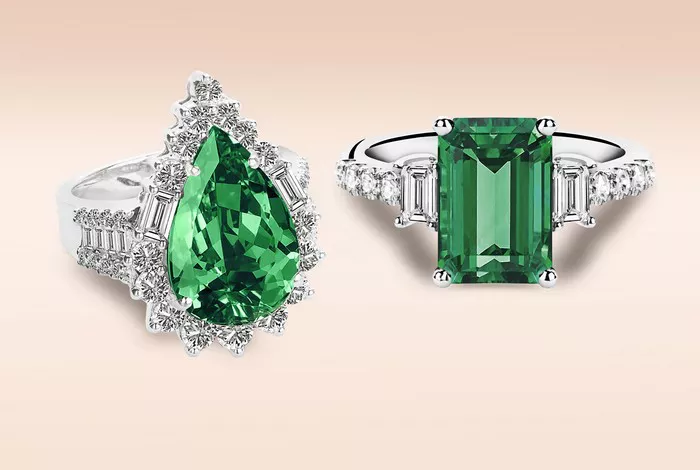In the world of gemstones, jade and diamonds occupy unique and prestigious positions. While diamonds have long been considered a symbol of wealth and luxury, jade holds immense cultural and historical significance, particularly in East Asia. When comparing the two, many people wonder, “Is jade more expensive than diamonds?” This article delves into the factors that determine the value of these two precious stones, examining their rarity, quality, cultural importance, and market trends.
The History and Cultural Significance of Jade
Jade, a term encompassing two different minerals – nephrite and jadeite – has been revered for thousands of years. Its use dates back to prehistoric times when it was fashioned into tools and ornaments. In Chinese culture, jade is more than just a beautiful stone; it symbolizes purity, wisdom, and harmony. Emperors prized jade, and it was often buried with them to ensure their protection in the afterlife.
Types of Jade
Nephrite: Found in regions such as China, Russia, and New Zealand, nephrite is typically green, but can also appear in shades of white, brown, and black. It is softer and less lustrous than jadeite but still highly valued.
Jadeite: Rarer and more valuable than nephrite, jadeite is primarily found in Myanmar (Burma). It exhibits a broader range of colors, including emerald green, lavender, red, and blue. The most coveted jadeite is the “Imperial Jade,” which is a deep, rich green.
The History and Cultural Significance of Diamonds
Diamonds have a relatively recent history compared to jade, but they have quickly become a universal symbol of love and commitment. The modern diamond engagement ring tradition began in the 19th century and was popularized by a successful marketing campaign in the 20th century.
Formation and Types of Diamonds
Natural Diamonds: Formed under extreme pressure and temperature conditions deep within the Earth, natural diamonds are brought to the surface through volcanic activity. They are graded based on the Four Cs – Carat, Cut, Color, and Clarity.
Synthetic Diamonds: Created in laboratories, synthetic diamonds possess the same physical and chemical properties as natural diamonds but are typically less expensive.
Factors Influencing the Value of Jade
Several factors contribute to the value of jade, making it a complex gemstone to appraise.
Quality and Color
Color: The most valuable jadeite is the Imperial Jade, characterized by its vivid, semi-transparent green hue. Lesser-quality jadeite may appear in paler or more opaque shades.
Transparency: High-quality jadeite is semi-transparent, allowing light to pass through and giving the stone a glowing appearance.
Texture: A smooth, fine texture without inclusions or blemishes enhances jade’s value.
Craftsmanship and Origin
Carving: Expertly carved jade pieces, particularly those with intricate designs and historical significance, can fetch high prices.
Origin: Jade from certain regions, such as Myanmar, is highly prized due to its superior quality.
Market Demand
Cultural Importance: In markets where jade holds cultural significance, such as China and other parts of Asia, demand can drive up prices significantly.
Investment Value: As an investment, jade can appreciate over time, particularly rare and high-quality pieces.
Factors Influencing the Value of Diamonds
Diamonds are valued based on a well-established set of criteria known as the Four Cs.
The Four Cs
Carat: A measure of a diamond’s weight, larger diamonds are exponentially more valuable.
Cut: The quality of the cut affects a diamond’s brilliance and overall appearance. Ideal cuts are highly sought after.
Color: Colorless diamonds are the most valuable, with grades ranging from D (colorless) to Z (light yellow or brown).
Clarity: Diamonds with fewer inclusions and blemishes are more valuable. Clarity is graded from Flawless (FL) to Included (I).
Rarity and Origin
Rarity: Exceptional diamonds, such as the rare pink and blue diamonds, can command astronomical prices.
Origin: Certain mines, such as those in South Africa, are known for producing high-quality diamonds.
See Also: Jade vs. Diamonds: Exploring the Value of Two Precious Gems
Market Demand
Jewelry Demand: Diamonds are highly coveted in the jewelry market, particularly for engagement rings.
Investment Value: High-quality diamonds can be a solid investment, often appreciating in value over time.
Comparing the Prices of Jade and Diamonds
Market Trends
The prices of jade and diamonds can fluctuate based on market trends and global demand. For example, during periods of economic growth, the demand for luxury items, including high-quality jade and diamonds, tends to rise, driving up prices.
High-Value Comparisons
Imperial Jade vs. High-Quality Diamonds: Imperial Jade, due to its rarity and cultural significance, can be more expensive per carat than high-quality diamonds. A top-quality piece of Imperial Jade can fetch prices exceeding $3 million per carat, whereas a flawless, colorless diamond typically costs around $15,000 to $20,000 per carat.
Average Quality Comparisons: For average-quality stones, diamonds are generally more expensive than jade. Mid-range diamonds can cost between $5,000 and $10,000 per carat, while similarly graded jadeite may cost significantly less.
Auction Records
Auction records provide insight into the highest prices paid for both jade and diamonds:
Jade: In 2014, a jadeite necklace known as the “Hutton-Mdivani Necklace” sold for $27.4 million at Sotheby’s, highlighting the extraordinary value of top-quality jade.
Diamonds: The “Pink Star” diamond, a 59.6-carat pink diamond, sold for $71.2 million at Sotheby’s in 2017, making it one of the most expensive gemstones ever sold.
Conclusion
The answer to whether jade is more expensive than diamonds is nuanced and depends on various factors, including the quality, rarity, and cultural significance of the stones in question. While top-quality Imperial Jade can surpass the price of high-quality diamonds, on average, diamonds tend to be more expensive due to their universal appeal and established market standards.
Both jade and diamonds hold unique places in the world of gemstones, each with its own allure and value. Understanding these differences can help collectors and enthusiasts appreciate the distinct qualities that make each gemstone special. Whether you are drawn to the rich history and cultural significance of jade or the timeless brilliance of diamonds, both stones offer unparalleled beauty and value.

